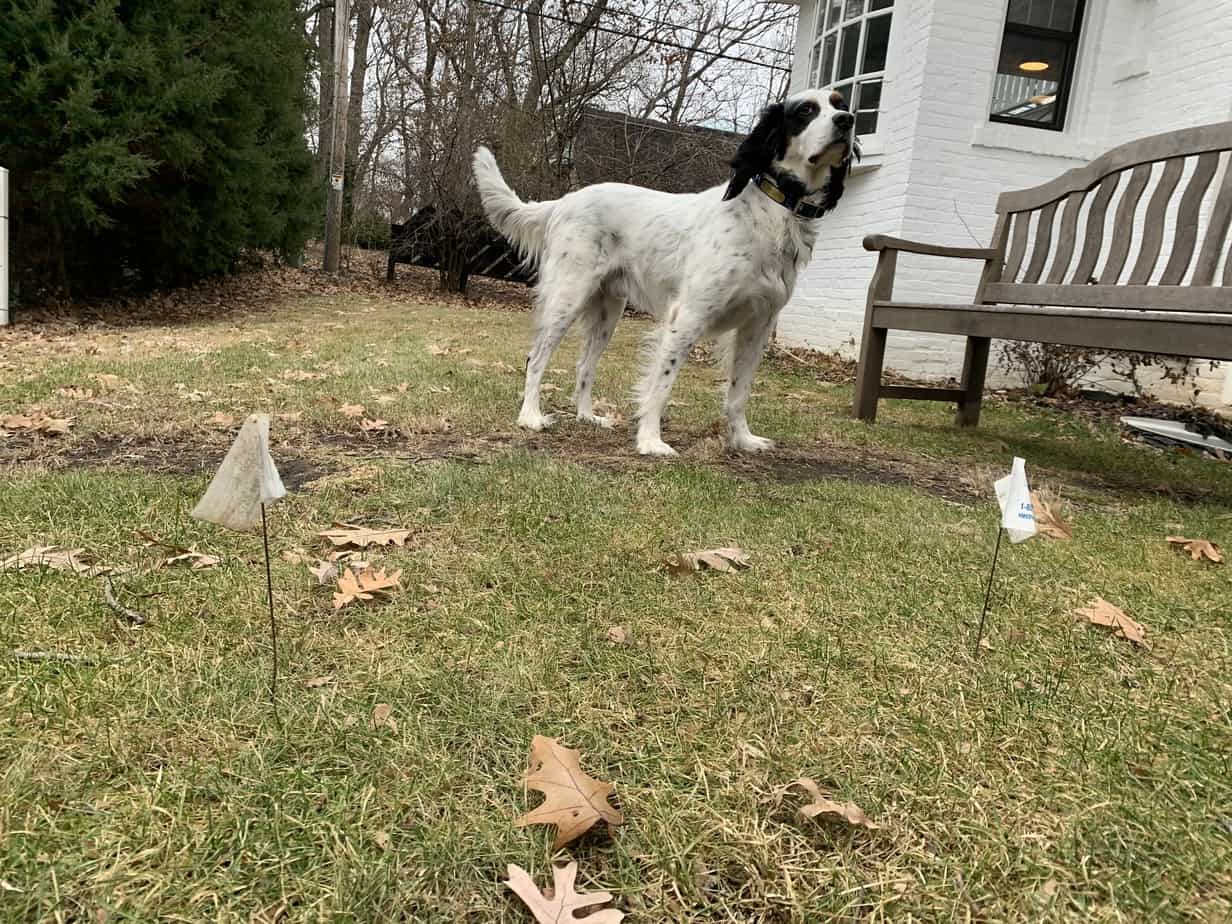
Training hunting dogs is a delicate combination of skill, experience, reaction, and a whole lot of art and finesse. Cultivating the natural-born talent of a young dog requires more than just a little luck and faith in his instincts. And there is a world of skill sets that the dog must learn and master before he’s ready to join his master for a day of birding. Even more so if the plan is to trial him.
There are all sorts of ideas and theories and standards and opinions regarding what you can and can’t and should and shouldn’t do through the course of a hunting dog’s life regarding his training. One of the hot topic debates for trainers and handlers alike is whether or not you should use underground fences for hunting dogs. That’s a weighted question for sure!
The short answer is: yes, you can use an underground fence if you have a hunting dog. Or, at least, you can for most dogs. The long answer is that often training the difference between the electric stimulation to stay in the yard and the electric stimulation used in the field takes patience, hard work, and dedication.
If you put all of those things together, your chances for success through both endeavors are much higher.
Sandra Misaras, a professional trainer in Boone, Michigan, hunts her dogs almost daily. She started with the inground wire fence, and when the wire broke in the middle of one blustery winter 13 years ago, she switched to a wireless unit. “The fence has no effect on bird dog training or hunting,” she says. She ought to know. She has titled several dogs and trained the runner up Gun Dog of the Year with the Ruffed Grouse Society trial series.
Are Hunting Dogs More Likely to Escape Underground Fences?
All dogs have the potential to take to your training or to fail. That’s a given in any situation. The first time you move from a blank gun to a shotgun, your dog could react poorly to the new stimulus, even when you’ve done all the homework and desensitizing and building the bird drive leading up to that moment perfectly. It just is.
Your chances of having success with introducing an underground fence will be far greater if you follow the training guidelines designed by the fencing gurus and trainers – to a T. No matter how smart your dog is, you can’t just have the fence installed and turn your collared dog loose, expecting him to figure out how to stay in the yard.
You’re looking to help your dog understand that crossing the boundary means they’ll receive a correction of some sort. They can avoid the correction by heeding the warning beep. The process involves spending several short sessions a day over a period of about two weeks, graduating through levels of improvement.
Phases include:
- Boundary Awareness: Working with your dog on a leash along your flagged boundary. The receiver collar at this point is set to only beep with no electric shock
- Introduce Static Correction: Beginning with the mildest setting and your dog still on leash, you’ll start to incorporate the electric stimulation to reinforce your verbal and leash training, backing up the warning beep.
- Temptations and Distractions: You’re upping the ante here, introducing distractions that may cause your dog to forget he has any brain cells.
- Off-Leash Supervision: With you still closeby as a mental and verbal backup if necessary, your dog can begin to stretch his legs and test his new boundaries on his own.
- Relaxed Monitoring: Without the need to keep your dog under your gaze the whole time, just check on him every now and then so you can correct him if he goes astray.
There are plenty of articles and training videos on exactly how to work your way through each of these steps. But it still all boils down to training.
Even with the time and effort put in, still about 30% of dogs fail their underground fencing training. We’re not sure what the exact statistics are, but it would be safe to assume that high drive dogs like sighthounds and hunting breeds would probably be ranked more often among those. And training and aptitude make a big difference. If you’re having trouble getting your dog steady to wing and shot, you’ll probably have trouble keeping your dog from chasing rabbits out of your yard, too.
There seems to be a general consensus among the ranks that dogs who have had a season or two of an e-collar in the field tend to have an easier time learning how to navigate the yard surrounded by an underground fence.
Will An Underground Fence Interfere with E-Collar Field Training?
It all boils down to your training and preparation.
Are you sensing a theme here?
Consider this: If you slap the fence collar on your dog, turn it all the way up, let him shock himself, run scared back to you, and you reward him for coming back to you and staying in the fence – you’ll have a big problem when it comes to using the e-collar in the field. The minute you flick the button to give your dog a minor correction or to stop the chase, he’ll turn tail and come barreling right back to your side.
That’s definitely not what you want him to do.
“Dogs are great differentiators, but poor generalizers,” Misaras illustrates. “The success of the use of the fence or your success in hunting all depends on the training behind it.” Dogs very well learn the difference between disparate collars and training modalities. You can take a dog into the conformation ring with his show lead and his rear end will never touch the ground. Take the same dog to obedience class with his buckle collar and leather lead, and he’ll sit at heel every time you stop – if that’s what you have consistently trained him to do while wearing those training aids.
By using two different e-collars (one for the fence, and one for the field), you’re signaling to your dog he has different jobs to do, depending on the feel of the collar and the sound of the tone. By properly conditioning the dog to perform as you desire slowly and building up a good foundation in both the yard and in the field, you can alleviate any confusion. There may be times when your dog gets confused, just as with anything you’re teaching him. That’s ok. He’s allowed to make a mistake. But when the training is in line, you can easily reconcile.
A common issue people run into is that their dogs tend to become collar wise. Any dog can become wise to where their correction is coming from, but the fence may speed that process up. For a hunting dog, it may not matter. But if you’re planning on trialing your dog, the use of an e-collar is not allowed. Working through the collar-smart may take a bit of time and practice, but it can be done.
What Kind of Electronic Fence Works Best With Hunting Dogs?
If you’ve decided to install an electronic fence for your dog, you’ll need to decide what type of fence to install. There are three main types of fencing available.
Underground Perimeter fencing is the type most people are familiar with. There are several well-known companies out there that will install the system and work with you to train your dog. There are also options available for self-install, too. Essentially, a wire is buried around the perimeter of the yard in the form of a loop. It sends out a signal with the help of a central transmitter. When your pet gets too close to the wire, the signal causes the collar to go off.
While a bit of a pain to set up initially and if anything should go wrong (like a broken wire), this is a great option if you have a lot of obstacles or oddities to your yard. You can choose where your dog can cross and where it cannot and tailor it to your yard.
Wireless fencing is a system that doesn’t use a buried wire. It relies on a centralized transmitter that emits a signal in a circular pattern radiating from wherever you have the transmitter. When the dog reaches the end of the circle, the collar is triggered.
These are very easy to set up, though they don’t allow for much personalizing at all. The size of the circle can be adjusted, but that’s about it. Some versions offer boosters that will work with the receiver to enlarge the size.
GPS fencing systems are more high tech. They use satellites to map the boundaries you set (geofencing). This can often be done through cellular technology. The collar is connected through the GPS program, which sends an alert if the pet gets too close to the boundary.
This, perhaps, is probably the least successful for use with hunting dogs, as there are several concerns to take into consideration. Due to the nature of GPS technology (a satellite high up in the sky), the boundary demarcation can vary pretty unpredictably – like up to 10 feet. GPS coordinates can shift and are often prone to interference and changes in signal strength. You’d have to adjust the distance from hazards accordingly, drastically reducing the size of your yard. Not a huge deal if you have vast property. Pretty significant if your yard is ¾ acre.
So adjusting your hunting dog to your new underground fence is a worthwhile endeavor if you’re without a physical fence for some reason. You need to be prepared to put the steps in to train it properly. If you’ve never trained a hunting dog before and have already had an electric fence, you may want to enlist the help of a skilled trainer to work you through the finer nuances of properly using an e-collar, so you don’t confuse the dog.
Invest the time and effort in the beginning, and just like anything else, it’ll pay off.
